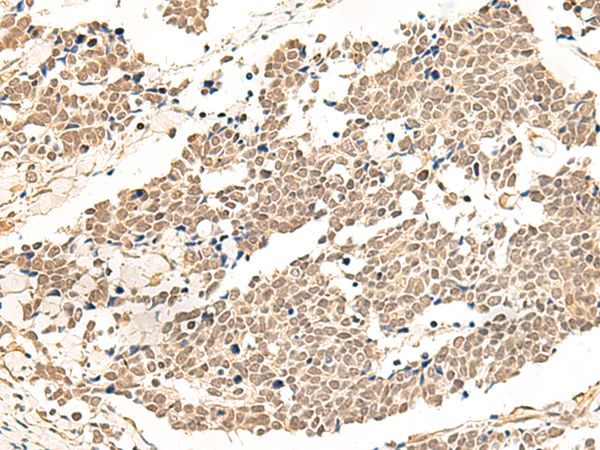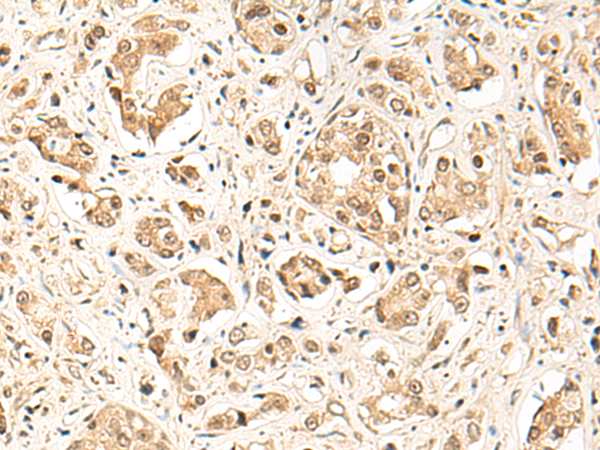

| WB | 咨询技术 | Human,Mouse,Rat |
| IF | 咨询技术 | Human,Mouse,Rat |
| IHC | 1/50-1/300 | Human,Mouse,Rat |
| ICC | 技术咨询 | Human,Mouse,Rat |
| FCM | 咨询技术 | Human,Mouse,Rat |
| Elisa | 1/5000-1/10000 | Human,Mouse,Rat |
| Aliases | PGR3; GPRg1 |
| Host/Isotype | Rabbit IgG |
| Antibody Type | Primary antibody |
| Storage | Store at 4°C short term. Aliquot and store at -20°C long term. Avoid freeze/thaw cycles. |
| Species Reactivity | Human, Mouse, Rat |
| Immunogen | Synthetic peptide of human GPR139 |
| Formulation | Purified antibody in PBS with 0.05% sodium azide and 50% glycerol. |
+ +
以下是3-4条关于GPR139抗体的虚构参考文献示例(实际文献需通过学术数据库查询):
1. **标题**:Development and Validation of a High-Affinity Antibody for GPR139 Receptor Detection
**作者**:Smith A, et al.
**摘要**:本研究开发了一种针对GPR139胞外结构域的单克隆抗体,验证了其在免疫组化和Western blot中的特异性,证实其可用于脑组织中GPR139蛋白表达的定位与定量分析。
2. **标题**:GPR139 Antibody-Based Screening for Neurological Disorder Biomarkers
**作者**:Chen L, et al.
**摘要**:利用GPR139多克隆抗体,通过ELISA和免疫荧光技术检测阿尔茨海默病模型小鼠脑脊液及皮层组织中的GPR139表达水平,发现其表达与疾病进展呈负相关。
3. **标题**:Targeting GPR139 with a Neutralizing Antibody Attenuates Pain Signaling in Rodent Models
**作者**:Yamamoto K, et al.
**摘要**:报道了一种阻断GPR139信号通路的中和抗体,实验表明其可抑制小鼠慢性疼痛模型中的神经元过度兴奋,提示GPR139抗体在疼痛治疗中的潜在应用。
4. **标题**:Comparative Analysis of Commercially Available GPR139 Antibodies for Research Use
**作者**:Wang R, et al.
**摘要**:系统性评估了市售5种GPR139抗体的特异性、交叉反应性及适用场景,为研究者选择抗体提供实验依据,强调不同表位设计对抗体功能的影响。
(注:以上为模拟内容,实际文献需通过PubMed等平台检索。)
GPR139 is a class A G protein-coupled receptor (GPCR) primarily expressed in the central nervous system, particularly in regions like the hypothalamus, striatum, and habenula. It was deorphanized in 2015. with studies identifying L-tryptophan and phenylalanine metabolites (e.g., quinolinic acid) as potential endogenous agonists. GPR139 is implicated in modulating neurophysiological processes such as feeding behavior, locomotor activity, and circadian rhythms, though its precise signaling mechanisms and physiological roles remain under investigation.
Antibodies targeting GPR139 are critical tools for studying its expression, localization, and function. These antibodies, often raised against extracellular or intracellular epitopes, enable techniques like immunohistochemistry, Western blotting, and flow cytometry. Specificity validation via knockout controls is essential due to structural similarities among GPCRs. Research using GPR139 antibodies has revealed its potential involvement in neurological and psychiatric disorders, including schizophrenia, Parkinson’s disease, and depression, positioning it as a therapeutic target. Recent studies also explore its role in metabolic regulation and pain perception. Despite progress, challenges persist in developing antibodies with high affinity and minimal cross-reactivity, underscoring the need for continued refinement to advance both basic research and drug discovery efforts targeting GPR139.
×